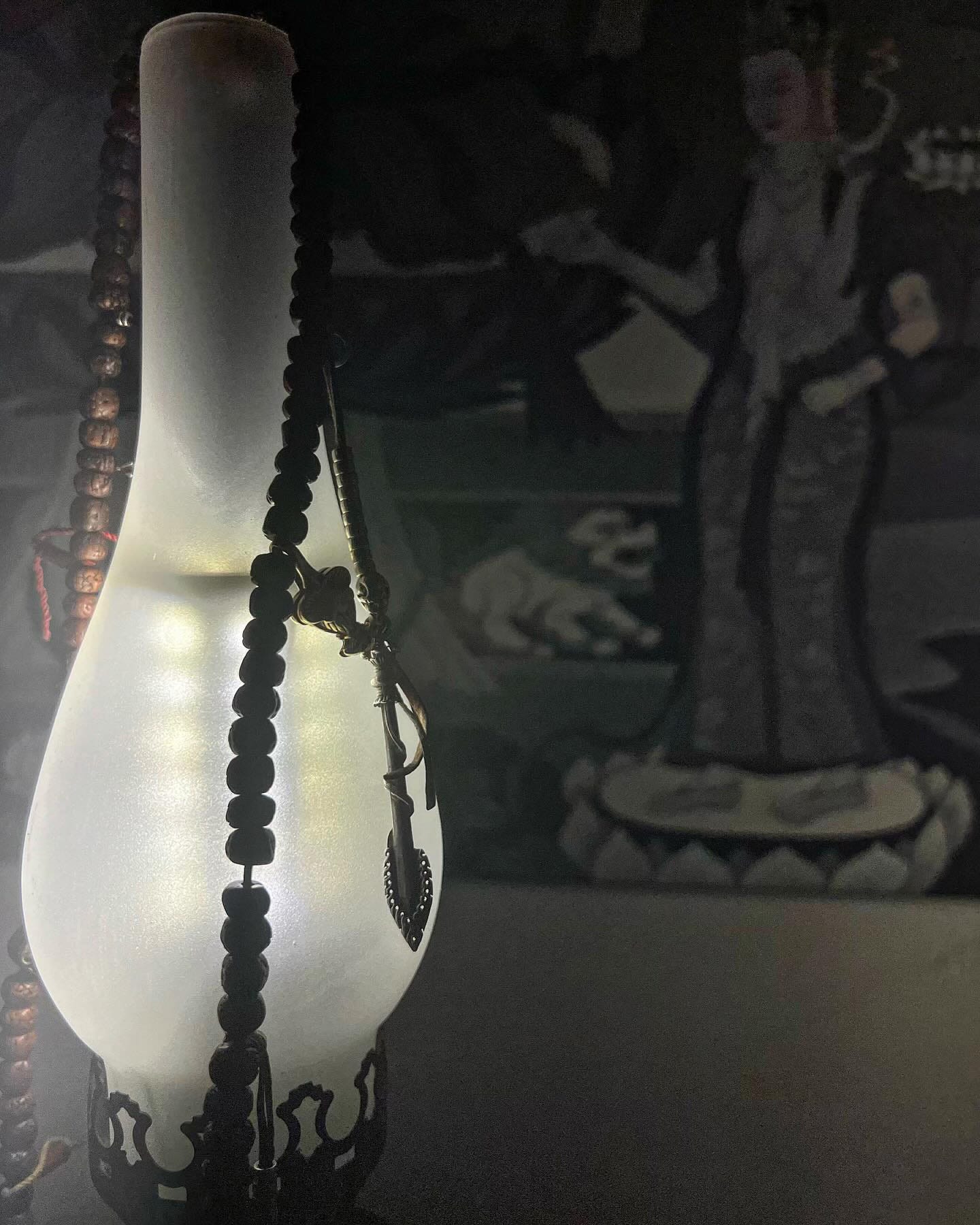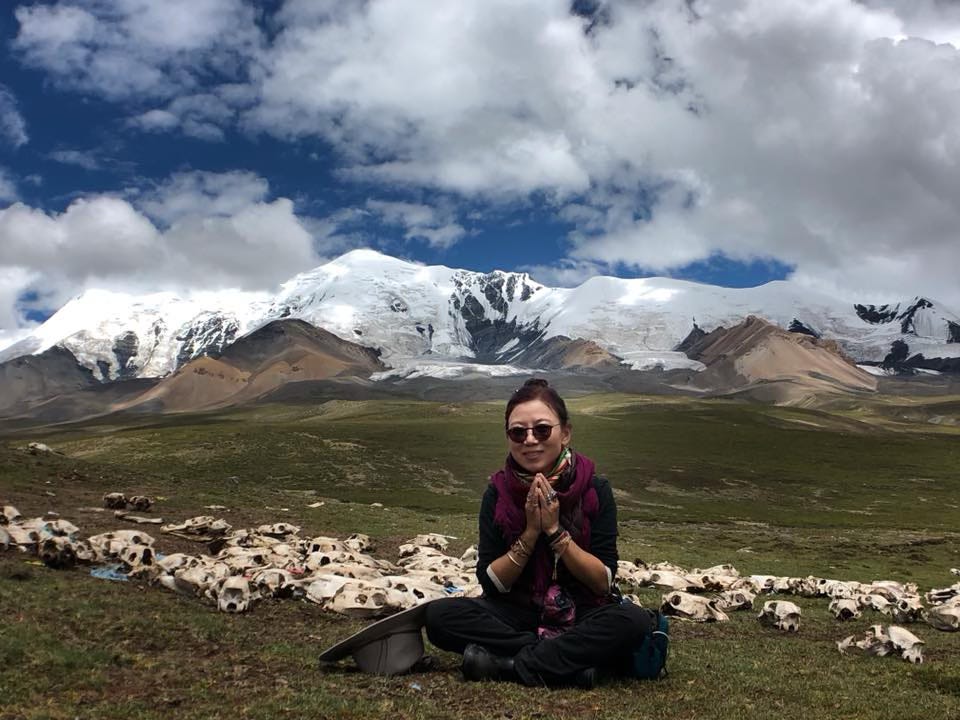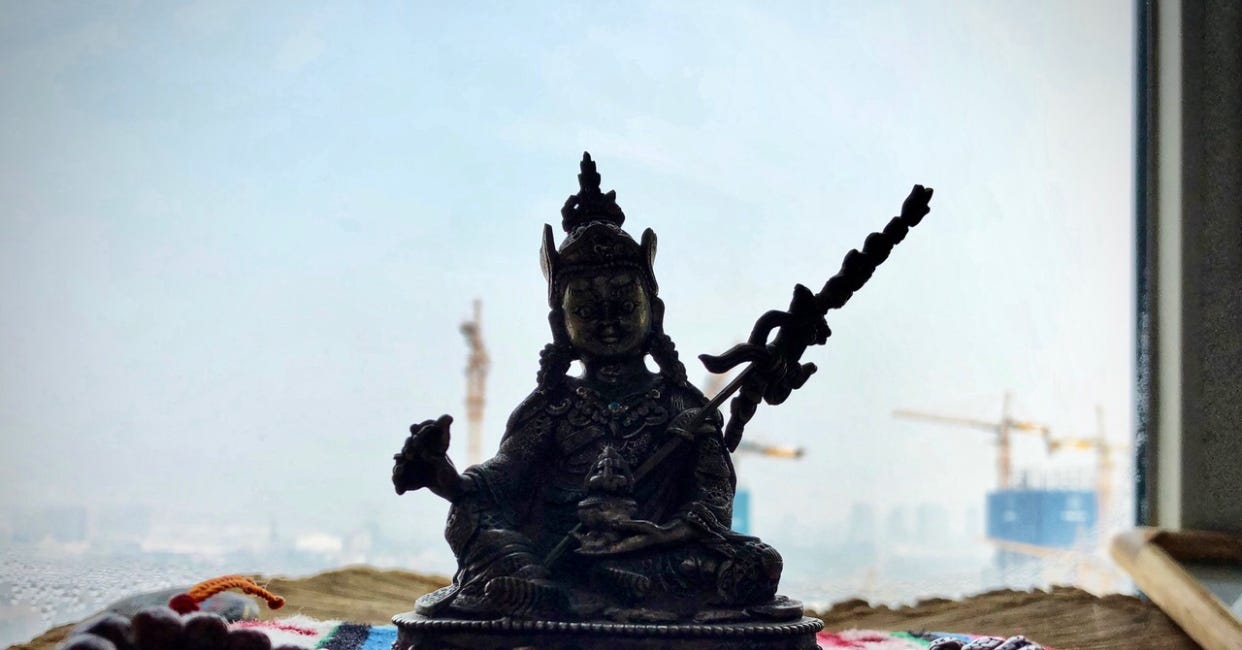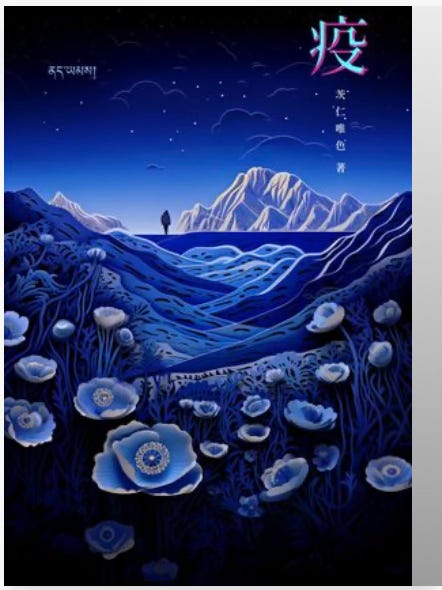Tsering Woeser & Ian Boyden:Experiencing the epidemic in Tibet | 唯色與譯者訪談:在西藏經歷疫情(附中文翻譯)
編者注:近日,西藏詩人唯色新作詩集《疫》由Liker Land出版推出。本書也是唯色出版的第一本NFT電子書。疫情爆發的時候,唯色正在拉薩。疫情讓她的詩歌噴湧而出。《波士頓書評》昨天刊發了其中的一組詩《時疫三行詩》。經作者授權,《波士頓書評》今天刊發《疫》後記,作者唯色和她的英文翻譯Ian Boyden的對談。訪談、翻譯 by Ian Boyden。原發China Heritage.
購買NFT電子書《疫》,點擊連結:
《波士頓書評》努力打造一個無禁區的讀書平台。您若是覺得不錯請轉發此郵件給朋友,無法翻墻到網站訂閱請發郵件 boshidunshuping@gmail.com
推特跟蹤:波士頓書評
Tsering Woeser
In Conversation with Ian Boyden
27 March 2020
Boyden: This cycle of forty poems offers a meditation on cause and effect. They allow us an insight into how you — as a writer, a Buddhist, a Tibetan in exile, and a political dissident — perceive and respond to the coronavirus pandemic, one that is unlike anything any of us have ever experienced. For my part, I feel as though I am walking around in a daze, and I know many others have a similar feeling of disjuncture. I think your interconnected series of poems can help us see through the darkness. Can you tell me how this work came into being?
Woeser: You’ll recall that the initial draft that I sent to you in early March consisted only of twenty-eight sections or verses. However, as the plague spread, my contemplation of things shifted increasingly inwards, towards my innermost heart. Poems began to flow from me until they took their present form. From the moment I started writing this cycle of poems, I felt that I was no longer alone; I knew everyone shared the same state of anxiety. Yet also, from the start, I had a strong sense that, to quote my poem, ‘No place exists that will not fall to the enemy / No epidemic exists that is not terrifying’. In fact, I felt that concurrent with this biological plague, another far more terrifying plague is at large. To put it another way, it is precisely because of this other plague that the present infectious disease has appeared and run riot.
The theme of cause and effect emerged as I started writing. Countless people are bewildered by the origin of what in Chinese is often called ‘Wuhan Pneumonia’ 武漢肺炎, or the coronavirus, which has now become a pandemic. But if you apply this single Buddhist phrase to the issue, you may have a clearer understanding of the situation:
‘If you wish to understand your conditions in this life, look at your actions in previous lives. If you wish to understand your conditions in future lives, look at your actions in this life.’
Or, to quote that well-known Chinese saying:
‘If you plant melons, you harvest melons. If you plant beans, you harvest beans.’
It was ideas such as these that, added to the epidemic itself, led me to create the present work.
Boyden: I recently read an essay written by Susan Sontag in 1978 titled ‘Disease as a Political Metaphor’. In it she says:
‘Any important disease, whose physical etiology is not understood, and for which treatment is ineffectual, tends to be awash in significance… . The disease itself becomes a metaphor.’
Thus, cancer becomes associated with the unregulated growth and metastasis of capitalism; tuberculosis is equated with the profligacy of wealth, and so forth. The first stanza of your poem reads, ‘No, there exists another plague far worse than this one.’ Are you thereby also using the very real, and devastating coronavirus epidemic also as a metaphor for an even more threatening political plague?
Woeser: This cycle of poems is not just a meditation on cause and effect. From the very first stanza, this work is also a political critique. In particular, it is a critique of that vast political plague, although I only hint at that in a veiled fashion because I am actually quite frightened. The political plague and the oppression that it has occasioned never eased up during the time that I was writing these poems; the advent of the coronavirus did not lead to a suspension of everyday politics; in fact, it has continued unabated. Over this period, I was repeatedly cautioned by the state security organs [not to speak out of turn] and a number of my friends, even those living quite far away, were threatened because of me. Under the conditions of totalitarianism such is our everyday reality.
The line ‘there exists another plague far worse than this one’ is the kernel of the work. So, yes, by ‘another plague’ I am referring to a political plague — tyrannical governance as well as the actual organs of repression and the thuggish sway in which it operates. Tyranny is akin to a virus. When I write of the ‘other plague’, I am talking about many things: destiny, the fate of humanity, as well as the dictator, regardless of which dictator.
Boyden: Throughout the poem there are many places where the subject or object remains intentionally ambiguous. For instance, when you quote the Sutra of the Fundamental Vows of the Bodhisattva Kṣitigarbha [1], you write ‘Its waters seethe and boil….’ What does that ‘it’ refer to, and how is that particular subject transformed as the poem unfolds?
Woeser: In the original sutra, ‘it’ refers to the ocean. The passage is wonderfully descriptive. A young Brahmin girl is praying for her mother’s salvation:
‘After meditating for one day and one night, she suddenly finds herself at the shore of the ocean. Its waters boil, many evil creatures with iron bodies are flying over the ocean, rushing to the east and west. She sees men and women, by the hundreds of thousands, haunting the ocean, being fought over and devoured by the terrible beasts…. But the Brahmin girl, because she invokes the power of the Buddha, is naturally without fear.’
The ‘it’ in this particular poem within the larger cycle refers to the ocean of suffering and terror experienced by people today. ‘It’ is not just about the virus, it is also a metaphor for contemporary society, even the whole world in which we are living. This ‘it’ appears repeatedly throughout the cycle of poems and, depending on the context, ‘it’ has different meanings.
Ian: Hell on earth is certainly a recurrent theme in your work. I think, for example, of those lines from your earlier work ‘Revolutionary Fire’:
‘Each curling flame opens
into an interminable blank space,
another hellish lacuna in the pages of history.’
Woeser: The descriptions of hell in Buddhist sutras are very detailed, although people don’t usually think of them as being literal. To my mind, however, presently we are living in the six realms of samsara and circulating through the eighteen levels of hell. It is something that is happening right now. It is not a metaphor.
Boyden: Returning to the multiple meanings of the virus, a few weeks ago, Ai Weiwei made a similar distinction between the biological virus and the nature of a mental or political virus. He said:
‘Looking at it now, it appears that the epidemic in China is not a deadly plague, but a mental illness with no hope of reprieve.’ [Twitter, 12:03 AM, 8 February 2020]
Woeser: Yes, the state of mental illness provides an apt parallel. The mental illness of an individual, of a community, a whole regional, right up to a whole-of-society malady and even national psychosis. But here we are not talking about some recent infection, it has long ailed humanity.
Over time, China has repeatedly been infected by this ‘other plague’, one that has increased in intensity until it has become a chronic affliction. It may, in fact, prove to be incurable. As a Tibetan I have particularly strong feelings on this subject. I can find a resonance in the work of Sontag who, in her book AIDS and Its Metaphors [Farrar, Straus and Giroux, 1989], wrote about ‘the connection of exotic origin with dreaded disease’ [see p.50]. I had a profound response to this line, and I wrote in the margin of the book:
‘Then, as an exotic country, how many times have epidemics been brought to Tibet? Epidemics always accompany colonisation. So, when SARS was spreading in Beijing, in Lhasa we began to prepare for a formidable enemy. This is something worthy of investigation: in recent history, how many times has Tibet been subject to new epidemics? When people compare communism to AIDS, of course colonised Tibet will inevitably be infected.’
Boyden: Thoughts are contagious, and ideas about power may well be the most contagious of all.
Woeser: Thought follows action, and as a result ‘misfortune spreads to the four seas’. Just as George Orwell obsessed in 1984, ‘In the end the Party would announce that two and two made five, and you would have to believe it.’ This is a plague.
Boyden: From another angle, I have come to see this virus as a ‘strange moon’, one that illuminates the integument of our society, be it good or bad. What has it illuminated for you?
Woeser: If we see the virus as a ‘strange moon’, then will we not also see a strange world? For in a world we think that we know so well, the moon also seems to be familiar. As a result isn’t it all too easily ignored? But regardless of whether it is strange or familiar, the clear cold moonlight illuminating the dark of night also illuminates life itself. Under that light we can readily perceive the impermanence of all things. This is a good thing. However, my Buddhist practice leads me to believe that our present incarnation is just a single lifetime, one of many lifetimes that are bound together. Appreciating this may allow people a measure of relief, something that will help them avoid being consumed by anxiety and fear.
Boyden: During the present outbreak the virus is not just illuminating our social structures, I think it might also prove to be a transformative force. In some ways, your poem is a meditation on the chain of causation. ‘Bodhisattvas fear causation, ordinary beings fear effects.’ Can we shift the causal nature of the virus so that it ends up benefiting humanity?
Woeser: What you say aligns perfectly with my original intention. Yes, the cold and clear moonlight also illuminates a much deeper relationship, that is to say the law of causation, or karma. I was recently reading some of the poems of His Holiness the Fifth Dalai Lama [Ngawang Lobsang Gyatso ངག་དབང་བློ་བཟང་རྒྱ་མཚོ་, 1617-1682] and a line in ‘Tender Shoots and Agreeable Words’, a poem written almost four hundred years ago, really struck me: ‘Those whose karmic propensity is awakened will dance!’ What I detect among those suffering from this epidemic, only those who are so awakened will be able to dance the dance of life. It can be such a beautiful dance.
Is it possible, however, to transfigure the causal nature of this virus so that it may actually benefit humanity? That’s a topic that will prove to be of concern to every person. In other words, it will entail everyone’s responsibility. But that will only happen if people do good out of respect for the consequences of their actions.
Boyden: In stanza three of the first section of this cycle of poems you mention wild grass. Of course, I thought of Whitman’s Leaves of Grass, where each blade of grass is a symbol for the individual, the field of grass is human society itself, grass representing democracy. But you change course and say instead that ‘it’ (again, you never mention your actual subject) is like ‘garlic chives’. Can you elaborate on what you mean by garlic chives?
Woeser: The grass I’m thinking of has nothing to do with democracy, nor was I thinking about Whitman. Regardless of whether it is grass or garlic chives, what I am referring to here are those who are the most vulnerable, those who are harvested time and again again by scythes. Even though the wildfires burn endlessly, with the spring wind these vulnerable lives will be born once again [a reference to a famous Tang-dynasty poem by Bo Juyi 白居易]. However, the scythe hangs over the head of every blade of wild grass, over every stalk of garlic chives. It may cut a wild swathe through the field without a moment’s notice.
The expression ‘garlic chives’, 韭菜 jiǔcài, is a popular term on the Chinese Internet. Because garlic chives grow again after being harvested and can be cut down once more, the term is used to refer to the weak who are repeatedly exploited and unable to escape. The exploitation of the masses is referred to by employing the visual image of cutting garlic chives. Those that profit from this exploitation are equated with the sickle used to cut the garlic chives. Many people use this metaphor to describe themselves. Of course, we all know who is wielding the sickles.
Boyden: When this plague started, like many others I decided to reread Albert Camus. I found this observation from The Plague particularly relevant: ‘There’s no question of heroism in all this. It’s a matter of humane respect. That’s an idea which may make some people smile, but the only means of fighting a plague is humane respect.’
Woeser: This plague, which originated in Wuhan, China, has now spread throughout the world. It’s having an impact on different political systems, be they totalitarian or democratic, as well as different ethnicities and cultures, along with different geographies and different climates, etc. Of course, each will cope with it in their own way, although the responses will be only comparatively different. The most fundamental difference will be clear depending on whether there is a basic respect for our humanity or not. It is an obvious point.
If there is no respect for humanity, the epidemic will continue to spread. Only by placing our hopes in humane respect can we stop this plague. How else can it be done? This plague has created a community of human destiny [a Communist Party formulation prompted by Xi Jinping that the poet turns on its head here].
Boyden: Indeed, this is not the ‘community of human destiny’ envisioned by Hu Jintao or Xi Jinping. Viral diplomacy! Only a poet could be so subversive!
Woeser: [laughs]
Boyden: Here we have just started our first week of official shelter-in-place. There are no airplanes flying over head and almost no cars. It is so quiet. I feel as though the natural world is heaving a great sigh of relief. At the same time, there is also a terrible sense of foreboding. What was it like for you in Beijing?
Woeser: After two months of quarantine that original sense of doom has still not dissipated. For now it appears as though the government in Beijing has scored a victory against the epidemic. At this moment, although it is the dead of night I can hear the cacophony of traffic outside just like before. The silence imposed by the epidemic has been broken. Once again people are out and about busy making money.
Boyden: Actually, tonight I feel very lonely. I’m unwilling to tell my friends that, in reality, I’ve been in a state of self-isolation now for over a decade, something that’s not all that different from being quarantined. I’m not a hermit as such, but rather just on a journey of self-discovery. It’s one that is both simple and complex. I could say that I’m a translator with a heart permanently in exile. You? What is your normal life like, despite the fact that you have been branded as ‘politically sensitive’?
Woeser: Mine is a constant state of self-isolation! A few days ago, Ai Weiwei and I were discussing this very topic. For us a life in quarantine is nothing new. We have no difficulty adapting because we have been living in a state of sequestration for many years. We have long lived with our political plague for we are writers who insist on being truthful, people who fight for the right to express ourselves freely, who have lost all too many personal freedoms. As a result society treats us like a kind of toxic virus. We live in isolation from others; this was a fundamental reality for me long before this. To put it in another way: I have lived in internal exile for many years, so, naturally, I don’t think that the imposition of this kind of quarantine is particularly hard to bear.
Boyden: To whom are you addressing this poem?
Woeser: I wrote this poem for this moment. The moment of this plague. This plague is nothing less than a world war, a plague of invasion, slaughter, occupation, and colonisation. As a person caught up in this, as someone who bears witness, for me to fail to record it all in my own way would be a form of unforgivable betrayal. This time I have ended up recording this event with 120 lines of poetry. It’s not that long, but also not too short. My apologies for creating such a burden for the translator!
Boyden: Can we talk about the final stanza? First, I want to talk about Taneda Santōka’s haiku poem, translated into Chinese by Gao Haiyang. I wanted to find an English translation of it, but failed to do so. That turned out okay since I located the original Japanese and by doing so I realised that my interpretation of it is quite different from Gao who tells us that the poet is praying in a loud voice. But the original actually says, ‘Voice rises into the wind’ [風の中聲はりあげて]. Taneda doesn’t specify whose voice. It is likely his own, but it could be the voice of another, or that of the reader. The voice becomes one with the wind. There is a beautiful Buddhist ecology here that involves prayer and the dissipation of the chanting voice.
Woeser: I encountered Taneda’s haiku during the outbreak of the epidemic. I learned that he was a mendicant monk who travelled by foot, a monk who wandered through the clouds. His haiku is suffused with the ‘voice of the dharma’, and its language is beautiful. I read about how he felt walking with Buddhas and Bodhisattvas. Walking on the road. Walking in the wind. Walking and praying. To him prayer is as routine as chatting. I love the feeling of the wind. I think the wind that blows from snow-shrouded Everest is a true wind without impurities, it carries the smell of my homeland, Tibet. When I stood in that wind and chanted ‘I take refuge in the Bodhisattva Who Perceives the World’s Cries’ [南無觀音菩薩], I experienced a profound sense of consolation. As a result, I was not so anxious, not so fearful of the political plague.
I like the resonances of the original Japanese haiku even more. The way this voice floats in the wind, how this voice attaches to the wind, how it leaves its traces on the wind. This voice is a prayer in all languages be it Japanese, Chinese, Tibetan, English, or whatever. According to Buddhist tradition, we revere ‘The Three Refuges’: the Buddha, the Dharma and the Sangha, or the community of Buddhist monks.
Boyden: We have talked about this cycle of poems as a political critique and the virus as a metaphor. But they are also a prayer. You quote many texts — sutras, mantras, chants, as well as poems by Buddhist monks — but ultimately you are the one who is praying. In the final line, you ask for all the wandering souls to be released from the bardo, or the state of existence between two incarnations or lives. Can you talk about this? The bardo is a special place in Tibetan Buddhism, and I suspect in this poem it also acts as a metaphor.
Woeser: The meanings of ‘bardo’ are deep and varied. In Buddhist conceptions there are six kinds of bardo, and not all of them have to do with the state after death. I think that everyone who is struggling with the plague are in a kind of bardo, one that we need to free ourselves from. But in my poem I also call the thousands of departed souls who died as a result of the plague ‘wanderers’. They didn’t want to die; surely they still long for the realm of the living and so they linger in the murky limbo of the bardo. It is a harrowing and sorrowful state. As I wrote the last verse I prayed to Guanyin so that her great mercy and compassion might help these lost wanderers. I pray, as a Buddhist, for all of those lost souls and for their rebirth. As I am still in the realm of the living it is something I felt that I could do, and so I have.
***
[1] The Kṣitigarbha Bodhisattva Pūrvapraṇidhāna Sūtra, क्षितिगर्भ बोधिसत्त्व पूर्वप्रणिधान सूत्र, Ch. 地藏菩薩本願經 describes Kṣitigarbha, a Bodhisattva who took a vow not to enter nirvana until all the souls have been liberated from the various Buddhist hells. Among other things, this sutra addresses questions related to karmic retribution.
唯色:用這串念珠,念了七十多萬遍的觀世音菩薩心咒,從2022年8月(我母親過世,拉薩疫情封城)至今。故拍照紀念。(2024年1月10日)from 唯色Facebook
Chinese Text of the Conversation:
一位詩人回應瘟疫大流行:與唯色訪談
伊安:你寫的這四十首詩(集合為一首詩)是對因果的深刻沈思,使我們能夠洞悉你(作為作家,佛教徒,流亡的藏人,政治異見人士)如何感知和應對這場瘟疫的大流行。我們任何人都沒有經歷過這樣的疫情,我覺得自己迷路了,也知道很多人都有類似的感受,我覺得這樣的一首詩或許可以幫助我們在黑暗中看清楚這一點。你能告訴我這首詩是如何產生的嗎?
唯色:你知道我最初發給你的草稿只有二十八首,那是三月初。隨著這個瘟疫的蔓延,趨向內心的思考越來越深入,詩句也因此越來越湧出,而到最後成了現在這樣。一開始,肯定不止我一個人,相信誰都會被這看上去像是突如其來的瘟疫給驚嚇住。但也是從一開始我就有這樣的預感:「沒有一個地方不淪陷,沒有一種瘟疫不可怖」。事實上,我覺得伴隨著這個瘟疫而至的還有一種更可怕的瘟疫,或者說,這個世界正是因為有了這更為可怕的瘟疫,才會出現這場傳染病。因果關係從一開始就出現了!今天,無數的人在困惑這個名叫「武漢肺炎」或冠狀病毒的大流行,但用佛教的一句話來講就能明白:欲知前世因,今生受者是;欲知來世果,今生作者是。或者用更簡單的一句中國諺語來講就是:種瓜得瓜,種豆得豆。這首詩正是在我這樣的認知與感受中,被疫情醖釀著,產生了。
伊安:我剛讀完蘇珊·桑塔格(Susan Sontag)在1978年寫的一篇文章,「疾病是一種政治隱喻」。她寫道:「對任何重要的疾病,特別是如果其物理病因尚不明確,並且對於治療無效,往往充滿了含義 ……該疾病本身就成為一種隱喻。」比如癌症的異常且不受控制的增長,與資本主義的異常且不受控制的增長有關,結核病與浪費財富有關,等等。在你這首詩的第一節你寫:「不,更有他疫遠甚於此疫」。我不禁認為你把病毒流行當成比喻,指的是一場政治疫情,有這個含義嗎?
唯色:其實我的這首長詩不只是對因果的沈思,更是一首批判性質的詩歌。主要是對政治瘟疫的批判,但表達得比較隱晦,這是因為恐懼所致。事實上在這首詩的寫作過程中,政治瘟疫的壓迫並沒有停止,連暫停都沒有過,而是一直在進行中。我兩三次受到壓迫者的警告,我遠在好幾個不同地方的朋友因為我而被警察警告,這正是極權下的真相與現實。
「更有他疫甚於此疫」是這首詩的關鍵。這個「他疫」,是的,我指的正是政治瘟疫,包括暴政與暴力機器,以及暴民。暴政正是病毒本身。而「他」其實有多重意思:可以是命運,人類的命運。也影射了獨裁者,每一個獨裁者。
伊安:許多節在整首詩中,有主詞或受詞故意的含糊不清。例如,當你引用《地藏菩薩本願經》:「其水湧沸……」,「其」指的是什麼?該主題在你的詩歌中可能如何變化?這個「其」是病毒嗎?或是地獄?或是人間?
唯色:在經文中,「其」是海。其實這段經文對此有動人的描述。一位年輕的婆羅門女子為救贖業力深重的母親而祈禱:「經一日一夜,忽見自身到一海邊,其水湧沸,多諸惡獸,盡復鐵身,飛走海上,東西馳逐;見諸男子女人,百千萬數,出沒海中,被諸惡獸爭取食啖……時婆羅門女,以念佛力故,自然無懼。」
這個「其」在詩中也如同令人痛苦和恐怖的海洋,不只是病毒等等,而是我們所置身的當代社會或整個世界的隱喻,隨著詩句再現。
伊安:人間地獄當然是一個主題。我想起了你的詩《革命的火》里的這句:「透過熊熊火焰的縫隙,彷彿瞬間的空白」。
唯色:佛經中關於地獄的描述很細緻,但人們通常不會認為那就是現實。在我看來,我們正是生活在六道輪回之中,流轉於十八層地獄之間,甚至當下即發生。這可並不是比喻。
伊安:回到病毒的多重意義,幾個星期前艾未未也區分了天然病毒和精神病毒,在推特上寫:「現在看,中國流行的不是一場致命的瘟疫,而是萬劫不復的精神疾病。」
唯色:是的,精神疾病,非常準確的判斷。個體的精神疾病、社區的精神疾病、地區的精神疾病,乃至整個社會及國家。但不是才患上,而是源遠流長。
在一個漫長的歷史過程中被「他疫」感染,並且不斷地加深,乃至成為痼疾,甚至有可能是不治之症。我作為一個藏人,更有很深的感觸。我的意思是,正如桑塔格關於艾滋病及其隱喻那篇,其中寫到「異域來源與可怕疾病之間的聯繫」,我當時在閱讀時寫下這段話:「那麼,作為異域之國,帶給圖伯特的瘟疫又有多少呢?瘟疫伴隨著殖民化,所以當SARS在北京流行,拉薩竟也如臨大敵。應該做個調查,在圖伯特的近代歷史上,到底平添了多少過去從未有過的瘟疫?當有人把共產主義比喻成艾滋病時,被殖民化的圖伯特當然也不可避免地會淪為疫區。」
伊安:實際上,我們的思想可能是世界上最具傳染性的事物。關於權力的思想是最具有感染的力量之一。
唯色:思想伴隨著行動,以致於「禍流四海」。就像奧威爾在《1984》裡面的揭露:「到最後,黨可以宣佈,二加二等於五,你就不得不相信它。」這就是瘟疫。
伊安:或者換個方式,我開始看這種病毒就像是一個陌生月亮,照亮了我們社會的結構,無論好壞。它為你照亮了什麼?
唯色:如果要把病毒看作是一個陌生的月亮,那我們是不是突然來到了一個陌生的世界?因為在我們熟悉的世界,月亮也是熟悉的,那麼是不是也就容易被忽視呢?好吧,如果是陌生的月亮,那可能很不同,那在黑夜中特別清晰的月亮散髮著清冷的月光,可以照亮生命本身,也就會真切地看見生命的無常。這倒是一件好事。與此同時,我的佛教信仰讓我知道生命並不是這一世的,而是累世的,認識到這一點,會讓人多少有些釋懷,而不至於陷入焦慮和恐懼。
伊安:但這不僅照亮了我們的社會結構,我認為該病毒可能是一種革命力量。這首詩在某種程度上是對因果關係的沈思:「菩薩畏因,眾生畏果」。我們可以改變病毒的因果關係,使其最終讓人道受益嗎?
唯色:你說得太契合我的本意了。是的,與此同時,那清冷的月光也照亮了一種更深刻的關係,我認為是因果律,即業力。正如我最近讀到近四百年前的五世尊者達賴喇嘛的一首詩歌,其中這句擊中了我:「那些因業力而覺醒的人會跳舞」!我彷彿看見,在遭受各種瘟疫的眾生當中,只有因此而覺醒的人,才會跳起生命的舞蹈,那是非常美好的舞蹈。
不過是否可以改變病毒的因果關係,從而受益於人道?我覺得這與每個人自己有關,或者說是每個人自己的責任。只有人人因為畏果而去行善積德,這個世界的災難才會少。
伊安:在第一章的第3節中,你提及野草,我當然想到了惠特曼的《草葉》,其中每片草葉都是個人的象徵,草地是人類社會本身,草是象徵民主。但你忽然話頭一轉,說它像韭菜。你能否詳細說明這是什麼意思?
唯色: 不,我想到的野草跟民主沒有關係。我也沒有想到惠特曼。無論野草還是韭菜,在我看來都是弱者,最弱的生命,被那把大鐮刀割了一遍又一遍。雖然野火燒不盡,春風吹又生,但是大鐮刀就懸在每根野草或韭菜的頭頂,會隨時瘋狂地割啊割。
「韭菜」是中國時下流行的網絡用語。因為韭菜可以反復收割的特性,所以泛指所有被反復壓榨卻無力逃脫的弱者。而被反復壓榨的過程被形象地描述為「割韭菜」,那獲利的一方則被比喻為鐮刀。這個說法最初源於金融或經濟圈,但現在已經被相當多的人用來形容自己和他人。我們當然也知道那鐮刀比喻的是誰。
伊安:這場瘟疫開始後,我決定重讀加繆。我發現這種觀察特別有意義:「這一切裡面並不存在英雄主義。這只是對人道的尊重的問題。這個想法會讓人笑,抵抗瘟疫的唯一手段是對人道的尊重。」你對這個觀察有什麼想法?
唯色:這個發端於中國武漢的瘟疫現在遍及全球,不同的政治制度即極權社會與民主社會、不同的民族與文化、不同的地理與氣候等等,會表現出各種不同。這是通過比較而產生的不同,然而最根本的不同正是這個:是否對人道的尊重。這一點太明顯了,可謂有目共睹。
因為沒有對人道的尊重,才會造成這場瘟疫的蔓延。我們也只有寄望於對人道的尊重,才可能遏制住這場瘟疫。不然怎麼辦呢?這個瘟疫顯然已經造成了人類命運共同體。
伊安:在我們這裡,剛剛進入了官方隔離的第一個星期。沒有飛機,幾乎沒有汽車,好安靜。我覺得自然界正在呼吸。同時,有一種可怕的黑暗和某種預感:最黑暗的時刻還沒到來。那麼你在北京感覺如何?
唯色:我在經歷了兩個月的隔離之後,事實上,那種末日感並沒有消除,雖然現在北京看上去似乎取得了抗擊瘟疫的勝利。此刻已經是深夜,可是窗外樓下的大路上,車輛駛來駛去,發出很大的聲音,就像是因為瘟疫而死氣沈沈的這兩個月已經過去了,消失了,甚至可以被忘卻了,而人們又在為掙錢忙忙碌碌。
伊安:實際上,今晚我感到很孤獨。我不想告訴我的朋友,我已經以自我隔離的方式生活了十年多了,這與瘟疫的隔離沒有太大的不同……這不是作為隱士,而是一個試圖瞭解自我的人……又複雜,又簡單。有著一顆流亡之心的譯者。你呢?你怎麼會這樣敏感化地過生活?
唯色:自我隔離的方式!事實上前幾天,艾未未跟我和王力雄也討論過這個。我的意思是說目前的這種因為疫情而隔離的生活,對於我們其實並不陌生,也不存在難以適應的問題,因為我們早就被隔離多年了!在政治瘟疫的威脅下,我們作為寫作者卻因堅持真實的寫作,爭取言論自由的表達,而喪失人身自由的諸多權利。被當做某種病毒而與社會、與他人隔離的生活,在我已成了我的生活本身,或者說,多年來,我一直過著一種內心流亡的生活,所以我不太覺得目前的隔離會有多麼難熬。
伊安:你要寫這首詩給誰?這首詩的觀眾是誰?
唯色:我寫這首詩是為這個時刻:瘟疫時刻。這個不亞於世界大戰的瘟疫,不亞於侵略、屠戮、佔領、殖民的瘟疫。作為一個經歷者、一個見證者,如果不用自己的方式去記錄,那就是一種不可原諒的辜負。而我這次的記錄方式是寫下這首120行的詩歌。不算長,但也不短,辛苦譯者了!
伊安:我們談談最後一節。首先,我想談談中國譯者高海陽翻譯的種田山頭火的俳句。我試著尋找種田山頭火的俳句的英文翻譯,但找不到。不過這也很好,因為我找到了原始日語版本。我發現我的解釋與高的解釋大不相同。他的翻譯中,詩人正在大聲祈禱,但原文卻說:「聲音浮上著在風中:南無觀世音菩薩。」種田山頭火沒有指出是誰的聲音。很可能是他自己的聲音。但也可能是其他人的,也可能是讀者的。聲音隨風而來。這裡有一個美麗的佛教生態,伴隨著祈禱的風。
唯色:我是恰好在疫情期間讀到日本詩人種田山頭火的俳句的。你知道他是一位托鉢行腳僧人,也就是雲遊僧,他的俳句中對佛法的感受很深,而他的語言是很美的。我甚至讀出了他與諸佛菩薩一起行走的感覺。在路上走著。在風中走著。邊走邊聊,祈禱就像聊天一樣日常。我喜歡風的感覺,我覺得那風是從積雪的珠穆朗瑪吹來的,那是真正的純粹的風,帶著我的圖伯特故鄉的味道,當我在珠穆朗瑪的風中放聲念「南無觀世音菩薩」,會感到安慰和不那麼恐懼,包括對政治瘟疫的不那麼恐懼。
是的,我更喜歡日語版的那種感覺,聲音漂浮在風中,聲音附著在風中,聲音烙印在風中。而這個聲音是祈禱,日語的祈禱,漢語的祈禱,藏語的祈禱,英語的祈禱等等。以傳統禱詞的「三皈依」即皈依佛、皈依法、皈依僧來念出,即:皈依大慈大悲的觀世音菩薩。你知道,漢語的「南無」正是皈依的意思。
伊安:我們已經把這首詩說成是政治批判了,把病毒當作比喻了,但這首詩也是祈禱。在整首詩中,你引用了許多佛教本文 (佛經,心咒,僧人傳記,僧人的詩歌),但最終是你自己的祈禱。在詩的最後一行中,你邀請中陰里漂泊的靈魂再生。在密宗里,中陰是一個很特別的狀態,我覺得也可能是這首詩的隱喻,你是否能談談?
唯色:中陰的意思很深。佛法對中陰的說明有六種,而不單單只是指人死後的一種狀態。我甚至認為我們——全世界面臨瘟疫的襲擊而掙扎的人——正處於一種中陰之中,而我們需要走出這種中陰。同時,我把死於這場瘟疫中的成千上萬的亡靈稱為「徘徊者」,是因為這些亡靈都是突然被瘟疫奪走生命的人,並不願意死亡,肯定留戀人間的一切,所以在中陰這個灰蒙蒙的空間里徘徊,非常地可憐而不幸。我因此寫下這最後的一行,是想祈求大慈大悲的觀世音菩薩幫助這些突然殞命的人。我是以一個佛教徒的方式,在這首詩的最後為亡靈祈禱、回向。而我作為一個活著的人,我能做到的,也僅僅是這樣了。
— Ian Boyden, 2020.iii.27
唯色寫作理念:寫作即流亡;寫作即祈禱;寫作即見證。
Woeser 唯色 | 時疫三行詩(English Translation attached)
編者註:近日,西藏詩人唯色新作詩集《疫》由Liker Land出版推出。《疫》為NFT電子書,也是唯色的第一本NFT書。經作者授權,《波士頓書評》刊發其中組詩《時疫三行詩》。英文翻譯 Ian Boyden。原發China Heritage. 購書點擊連結: 《波士頓書評》努力打造一個無禁區的讀書平台。您若是覺得不錯請轉發此郵件給朋友,無法翻墻到網站訂閱請發郵件 boshidunshuping@gmail.com 推特跟蹤:波士頓書評 時疫三行詩 唯色 第一章 1、 沒有一個地方不淪陷 沒有一種瘟疫不可怖








